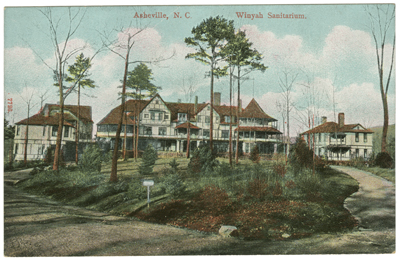We recently designed a display case in the NCC’s reading room that shows postcards from a variety of therapeutic destinations in the early 20th Century. We’ve selected postcards showing sanitariums, healing springs, and coastal resorts to illustrate the different types of accommodations that became increasingly more popular after the establishment of the railroad in North Carolina. We’ll post a blog entry for each type of institution over the next few weeks.
In an effort to treat patients with tuberculosis, sanitariums were built across the state, but many were located in Western North Carolina. These facilities boasted clean, fresh air, restful scenery, and a slew of attendants and physicians to care for their ailing clients.
The railroad to Asheville was completed in 1882, making travel to Western North Carolina more convenient for those seeking to access the sanitariums and healthy climate of the mountains. Pamphlets for both the sanitariums and railroads at this time often advertise their services in tandem:

This excerpt from a Southern Railway pamphlet, ca. 1898, is a prime example of how the railroad company used the benefits of Western North Carolina’s climate to laud their own service.
More postcards of sanitariums can be viewed online here.


The transcontinental railroad was completed 10 May 1869, but the railroad did not arrive in Asheville, North Carolina, until 1882! What’s with that?
Thanks for pointing that out, Rick.
I’ve been looking into what delayed the arrival of the railroad to Western North Carolina, and Starnes’ “Creating the Land of the Sky: Tourism and Society in Western North Carolina,” lays out a nice argument. Starnes notes that the Civil War interrupted the construction of The Western North Carolina Railroad (WNCRR). The WNCRR went bankrupt and was taken over by the state during Reconstruction (p. 24).
I imagine other railroad companies hoping to build into Western NC experienced similar problems. Other sources note that it was expensive and difficult to build railroad track through the mountains, and tourism was just in its infancy before the railroad was formally established. These factors also likely contributed to the later date.
I found an obituary for my great uncle’s child, J.B. Rogers who died at 26 years old. The obit tells how that although he was from Giles County, Tennessee, he died the 15th of Aug 1943 while receiving treatment in Ashville, NC at a place called:
Rove Cottage Sanitarium.
I had no idea what he was being treated for so I began researching the internet from my Indiana home in hopes of finding out more about the sanitarium and in turn discover what my great uncle’s child may have been suffering.
After reading the information at this site and also a site from the National Parks Service that provides a brief history of sanitariums in the Ashville area I can only assume for now that J.B. Rogers was being treated for tuberculosis.
My own grandmother died of tuberculosis in Arkansas in 1945 when my father was only 14 years old. What you are featuring here is an important piece of history. If my grandmother could have survived 5 more years she would have lived long enough to see effective treatments and a vaccine. I was born 10 years after her death and never had the pleasure of knowing her. I have come to understand that some doctors and scientists in the Ashville area dedicated themselves to researching cures for tuberculosis. Now a case of tuberculosis is rarely heard of.
If anyone can lead me to historical photos and/or documents that would inform me about the Rove Cottage Sanitarium in Asheville I would be most appreciative. It will help me solve a family genealogy puzzle.
Victoria:
You may want to contact the special collections department in the library at the University of North Carolina at Asheville and the North Carolina Collection at the Asheville-Buncombe Public Library. There might be a photo of the Rove Cottage in one these collections.
Unfortunately, I was unable to find any photos or documents in the North Carolina Collection that relate to the Roye Cottage in Asheville. (I think the name of the sanitarium may be Roye Cottage instead of Rove Cottage.) It is listed in the Asheville City Directory between from 1923 until 1957 at the address of 110 Sunset Drive.
I second Kevin Cherry’s advice of contacting the special collections at UNC-Asheville and the North Carolina Collection at the Asheville-Buncombe County Public Library – they may have information that we do not.
Apparently, in 1930 the Roye Cottage was in Ward 2 in the city of Asheville. I believe that places it near the boyhood home of Thomas Wolfe. The boundaries of Ward 2 according to the 1930 census:
Asheville City, Ward 2 (Part), bounded by (N) Ward Line; (E) Ward Line; (S) Ward Line; (W) Vance, Woodfin, Charlotte.
Institution(s): Dr. Minor’s Sanitarium, Fairview Cottages Sanitarium, Roye Sanitarium, Stonehedge Sanitarium, Asheville Mission Hospital ,Sunset Lodge Sanitarium
See: http://www.us-census.org/states/northcarolina/teams/Buncombe1930-T626-1675.htm
In researching my former husband’s lineage, I find his grandfather, Anonymous W Redmond (yes, his name is actually Anonymous) died 24 March 1923 in Clifton Manor, Asheville, NC. Cause of death Tuberculosis. I find nothing on Clifton Manor in my search. I’m fortunate to have found his death certificate. I would love to know how long he was in this care facility. Are there records available nearly 90 years later?
Ms. Cross: I’ve checked our catalogs and several other resources here in Wilson Library without finding any records for “Clifton Manor.” I did locate a listing for “The Clifton Hotel” at 20 Patton Ave in Asheville in a city directory from 1912, but not much else. The “proprietor” is listed as A. H. Brooks and the manager is L. L. Weir. You may wish to contact the North Carolina Room at the Asheville-Buncombe Library. Their website is http://www.buncombecounty.org/governing/depts/library/NcCollection.aspx. In addition, the North Carolina State Archives may have records on sanatoriums (if this was one) in North Carolina during this time period. Their website is http://www.archives.ncdcr.gov/. Good luck with your search.
Donna Cross-It looks like “Clifton Manor” was the former “Swannanoa Hill Sanitarium” started by Dr. Paquin in a house near Kenilworth Inn in Asheville. There are references to the manor in th1 1922-24 city directories-but no “records’ of patients etc.
Dale Wayne Slusser Asheville
My wife and I purchased 110 Sunset Drive in 2012 and found the connection with Roye Cottage (it’s original name). There is a neighboring building that seems to have originally been a medical clinic with both part of the sanitarium. That structure is now a 12-unit apartment building, and owned by someone else. Our property is now a single-family home… and seems to have been so since the 1970’s. If anyone is in Asheville or interested in photos – feel free to contact me.
828-423-9484
Thank you for posting the info on Roye Cottage, until this I could find nothing as the Death Certificate for my Grandfather was written in cursive and not very clear. Wasn’t sure I was even on the right track, only being in Buncombe County Asheville NC
ROYE SANATORIUM AND THE DOUGHTY SISTERS
The Doughty sisters, Cynthia, Katherine, and Alice moved from Ohio to Asheville in 1896 and established three tuberculosis sanitaria, Edgewood, Hillside and Roye Cottages. The sisters and grandnephew, Otis Shackelton Sr, operated boarding houses and sanitaria until 1927 when Otis Shackelton sold Roye Sanitarium. The sanitaria were located near the intersection of Sunset Dr and Baird.
Shortly after the arrival of the railroad to Asheville in 1880, Asheville experienced explosive growth as a vacation and health center. Part of this growth was based on the theory that high altitude, clean air and a healthy climate could heal tuberculosis. Asheville became famous as a center for tuberculosis treatment. In 1900 there was one tuberculosis sanitarium. Eventually, there were 130 boarding houses and sanitaria in Asheville.
The Doughty sisters sold their property in Mt. Washington, Ohio and moved to Asheville in 1896. The Asheville City Directory for 1896 shows that the Doughty sisters were renting Hillside Cottage where Cynthia was the proprietor of a boarding house/sanitarium. They appear in the Asheville City Directory almost every year until 1925. In 1909 they placed the advertisement shown below in the Asheville City Directory.This is the first mention of the term Villa Roye.
Cynthia died in 1912 (age 70), Katherine died in 1923 (age 73) and Alice died in 1925 (age 71). The facility was inherited by Otis Shackelton, a grandnephew who moved from Cleveland, Ohio in 1913 to help operate the sanitarium. By 1925 the facility was no longer called Hillside Cottage; instead it was called the Roye Sanitarium. According to the Asheville Citizen the Roye Sanitarium was sold to J.J.Burton and M. Alva Powell for $40,000 in 1927. The property was to be used as an investment.
According to the Asheville City Directory, the Roye Sanitarium was still in business as late as 1957.